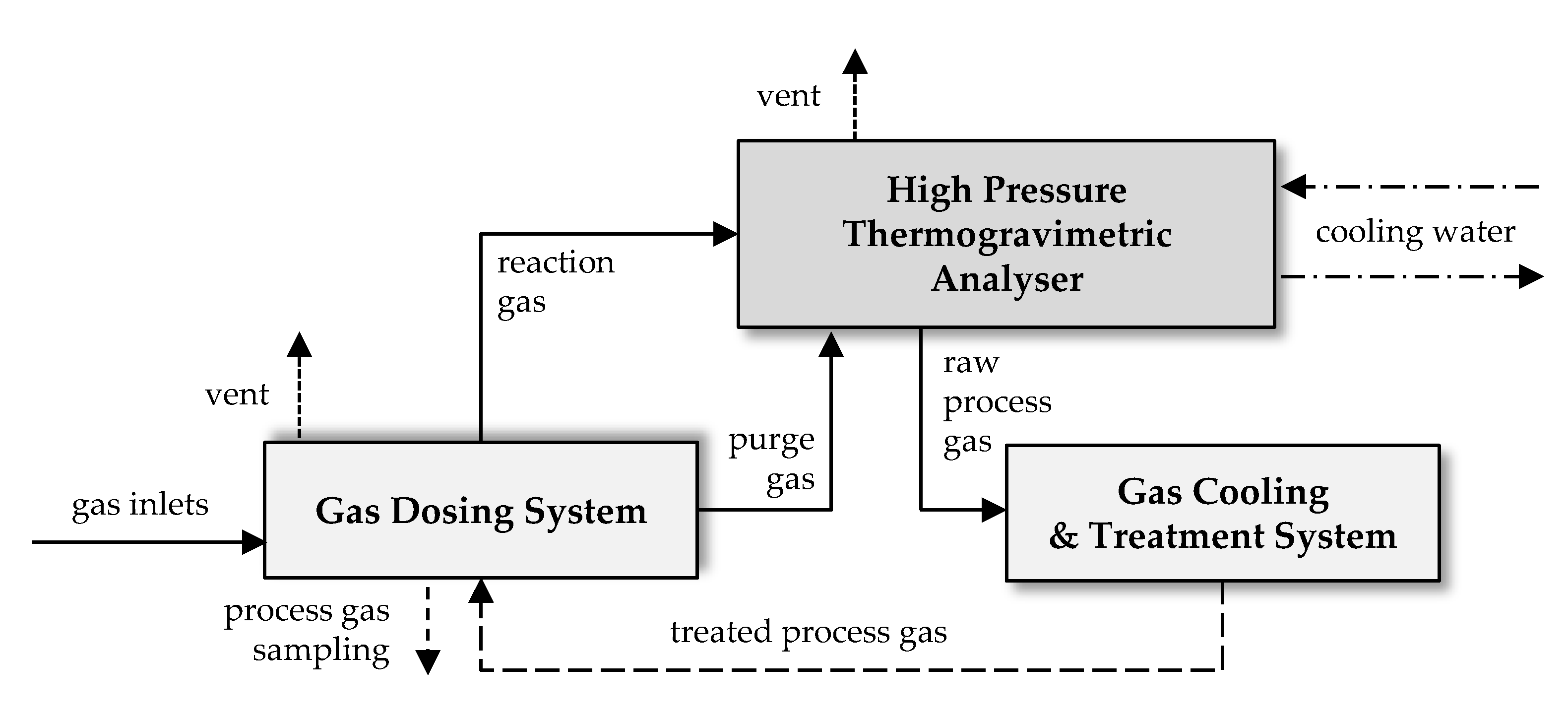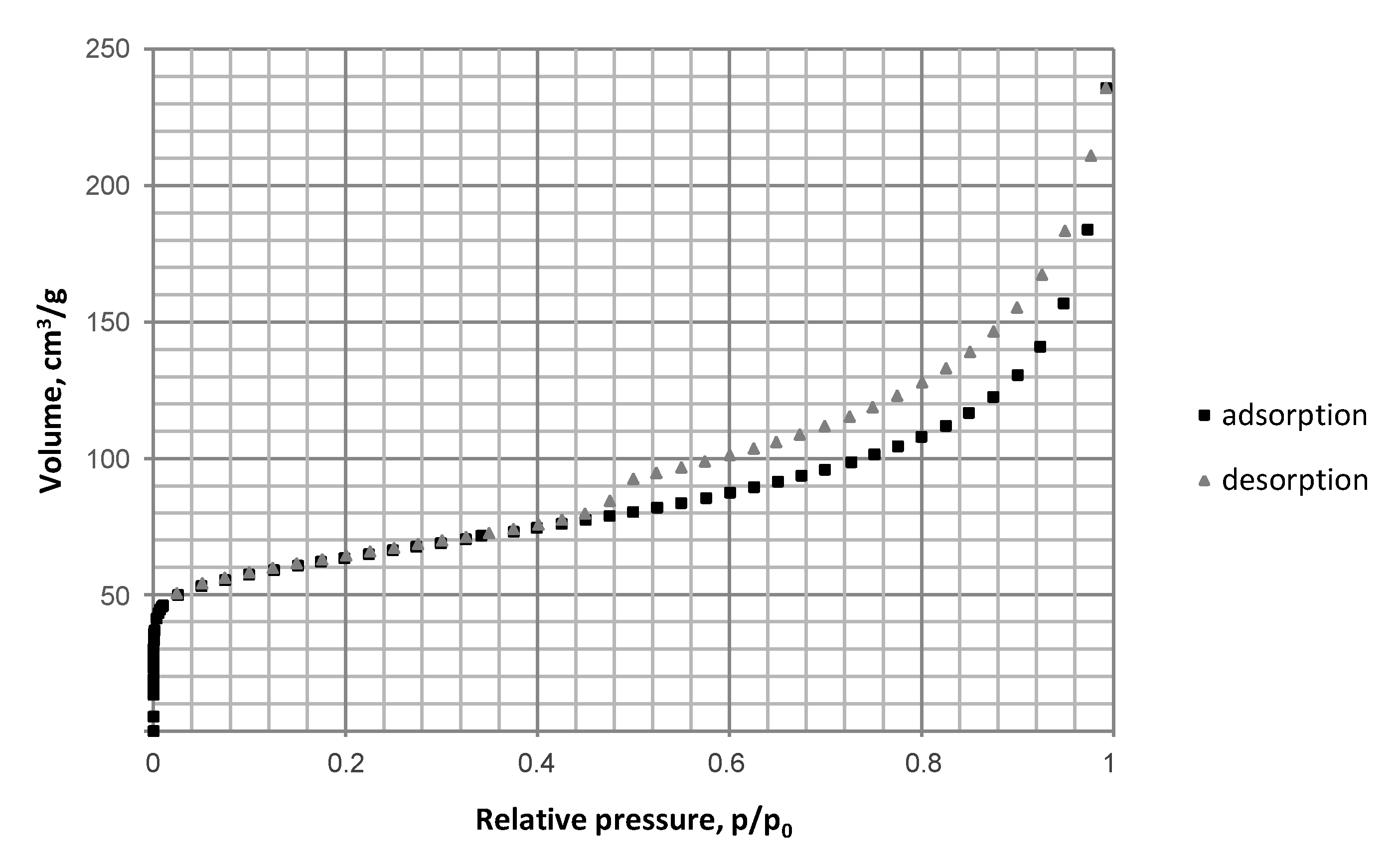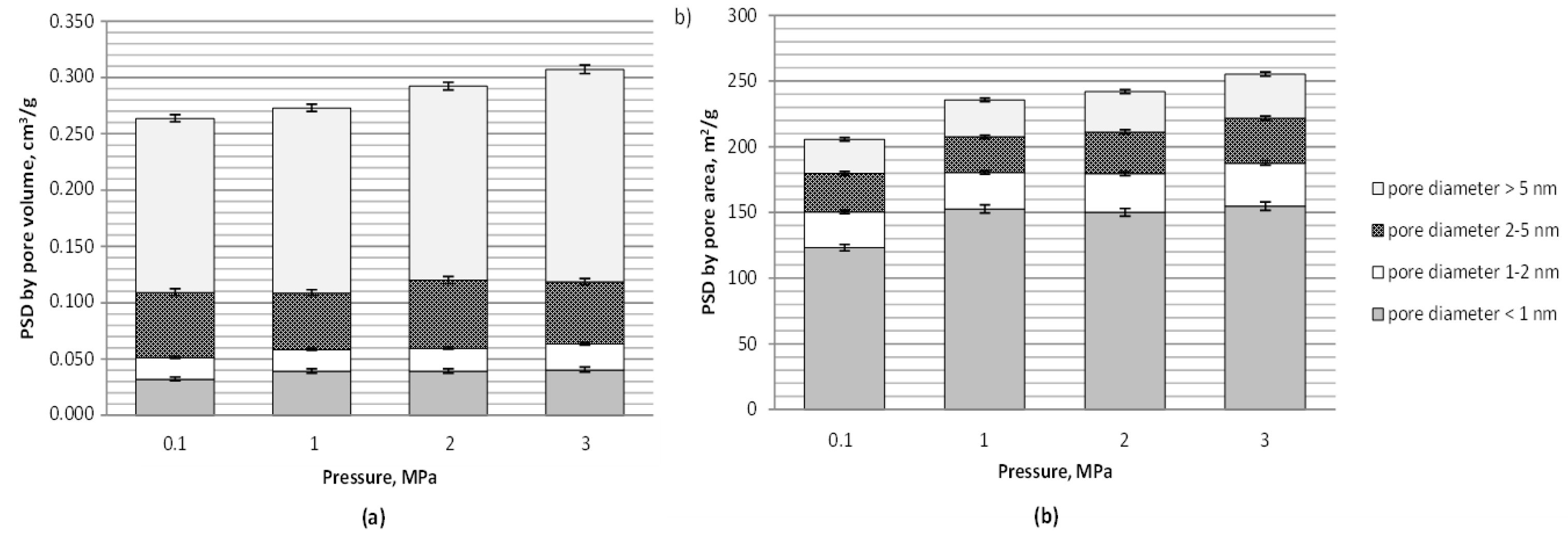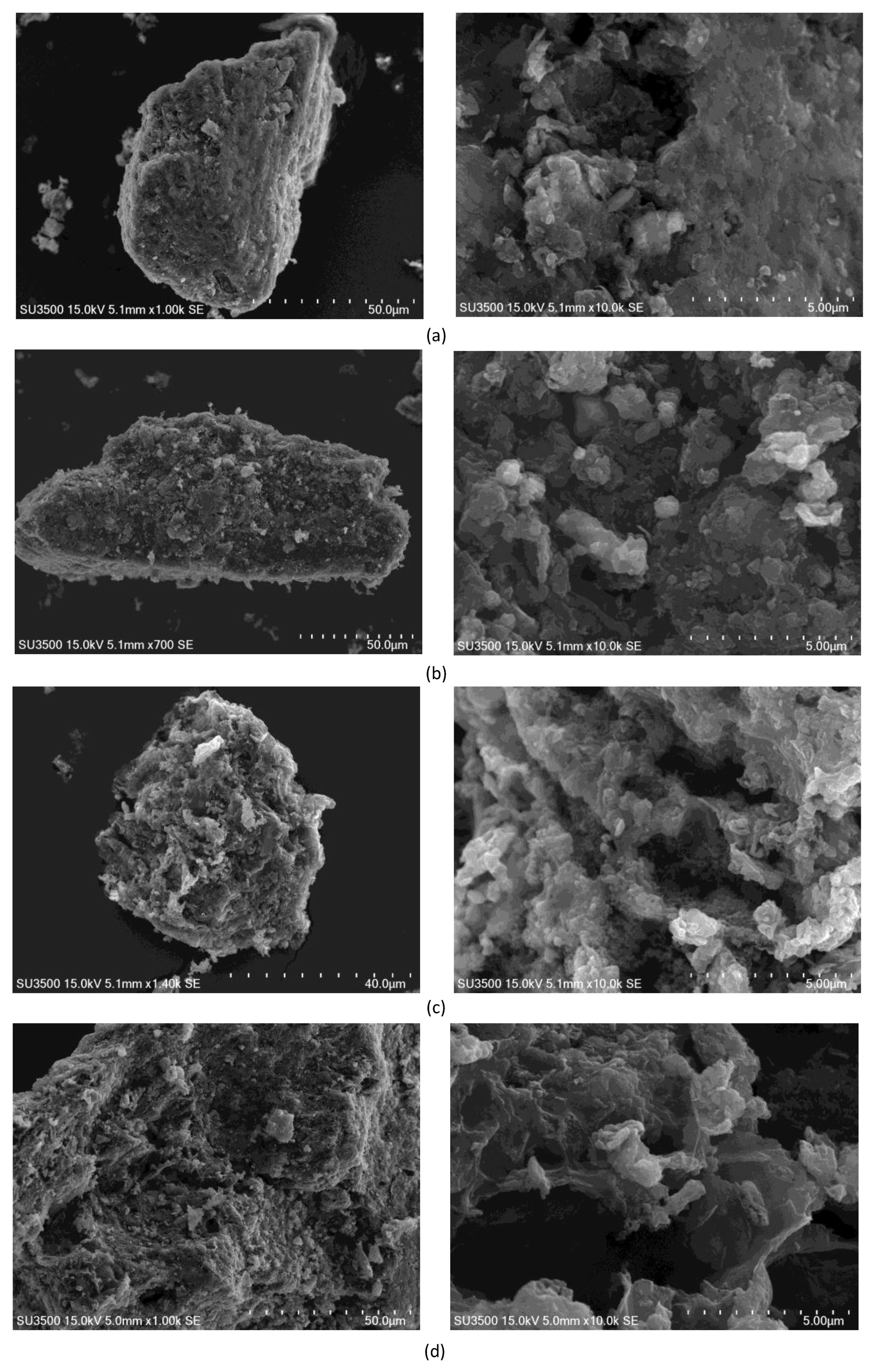Combined Effect of Pressure and Carbon Dioxide Activation on Porous Structure of Lignite Chars
Abstract
:1. Introduction
2. Materials and Methods
3. Results and Discussion
4. Conclusions
- The elevated pressure and high temperature may be successfully applied instead of partial carbon dioxide oxidation for production of lignite-derived chars of well-developed surface area and relatively low average pore diameter.
- Application of pressure in carbon dioxide-activation process at 800 °C results in generation of chars comparable or superior in terms of the specific surface area when compared to carbon materials received with demineralization and carbon dioxide activation of lignite, which implies that pressure may be considered as an alternative to demineralization preceding the carbon dioxide activation.
- The combined pressure and carbon dioxide activation may be effectively applied in conversion of poor quality lignite into porous materials.
Funding
Conflicts of Interest
References
- BP Statistical Review of World Energy June 2017. Available online: https://www.bp.com/content/dam/bp-country/de_ch/PDF/bp-statistical-review-of-world-energy-2017-full-report.pdf (accessed on 19 January 2015).
- Howaniec, N.; Smoliński, A. Biowaste utilization in the process of co-gasification with bituminous coal and lignite. Energy 2017, 118, 18–23. [Google Scholar] [CrossRef]
- Smoliński, A.; Howaniec, N. Co-gasification of coal/sewage sludge blends to hydrogen-rich gas with the application of simulated high temperature reactor excess heat. Int. J. Hydrogen Energy 2016, 41, 8154–8158. [Google Scholar] [CrossRef]
- Smoliński, A.; Howaniec, N.; Stańczyk, K. A comparative experimental study of biomass, lignite and hard coal steam gasification. Renew. Energy 2011, 36, 1836–1842. [Google Scholar] [CrossRef]
- Karaman, I.; Yagmur, E.; Banford, A.; Aktas, Z. The effect of process parameters on the carbon dioxide based production of activated carbon from lignite in a rotary reactor. Fuel Process. Technol. 2014, 118, 34–41. [Google Scholar] [CrossRef]
- Xing, B.; Huang, G.; Chen, L.; Guo, H.; Zhang, C.; Xie, W.; Chen, Z. Microwave synthesis of hierarchically porous activated carbon from lignite for high performance supercapacitors. J. Porous Mater. 2016, 23, 67–73. [Google Scholar] [CrossRef]
- Carrott, P.J.M.; Cansado, I.P.P.; Mourão, P.A.M.; Ribeiro Carrott, M.M.L.; Louro, N.D.B.; Albiniak, A.; Broniek, E.; Jasieńko-Hałat, M. On the use of ethanol for evaluating microporosity of activated carbons prepared from Polish lignite. Fuel Process. Technol. 2012, 103, 34–38. [Google Scholar] [CrossRef] [Green Version]
- Fukuyama, H.; Terai, S. Preparing and characterizing the active carbon produced by steam and carbon dioxide as a heavy oil hydrocracking catalyst support. Catal. Today 2008, 130, 382–388. [Google Scholar] [CrossRef]
- Lü, G.; Hao, J.; Liu, L.; Ma, H.; Fang, Q.; Wu, L.; Wei, M.; Zhang, M. The adsorption of phenol by lignite activated carbon. Chin. J. Chem. Eng. 2011, 19, 380–385. [Google Scholar] [CrossRef]
- Shrestha, S.; Son, G.; Lee, S.H.; Lee, T.G. Isotherm and thermodynamic studies of Zn (II) adsorption on lignite and coconut shell-based activated carbon fiber. Chemosphere 2013, 92, 1053–1061. [Google Scholar] [CrossRef]
- Skodras, G.; Orfanoudaki, T.; Kakaras, E.; Sakellaropoulos, G.P. Production of special activated carbons from lignite for environmental purposes. Fuel Process. Technol. 2002, 77–78, 75–87. [Google Scholar] [CrossRef]
- Chattopadhyaya, G.; Macdonald, D.G.; Bakhshi, N.N.; Mohammadzadeh, J.S.S.; Dalai, A.K. Preparation and characterization of chars and activated carbons from Saskatchewan lignite. Fuel Process. Technol. 2006, 87, 997–1006. [Google Scholar] [CrossRef]
- Aivalioti, M.; Pothoulaki, D.; Papoulias, P.; Gidarakos, E. Removal of BTEX, MTBE and TAME from aquous solutions by adsorption onto raw and thermally treated lignite. J. Hazard. Mater. 2012, 207–208, 136–146. [Google Scholar] [CrossRef] [PubMed]
- Tong, K.; Lin, A.; Ji, G.; Wang, D.; Wang, X. The effects of adsorbing organic pollutants from super heavy oil wastewater by lignite activated coke. J. Hazard. Mater. 2016, 308, 113–119. [Google Scholar] [CrossRef] [PubMed]
- Nwaka, D.; Tahmasebi, A.; Tian, L.; Yu, T. The effects of pore structure on the behavior of water in lignite coal and activated carbon. J. Colloid Interf. Sci. 2016, 477, 138–147. [Google Scholar] [CrossRef] [PubMed]
- Huang, H.; Wang, Y.; Cannon, F.S. Pore structure development of in-situ pyrolyzed coals for pollution prevention in iron foundries. Fuel Process. Technol. 2009, 90, 1183–1191. [Google Scholar] [CrossRef]
- Samaras, P.; Dabou, X.; Sakellaropoulos, G.P. Thermal treatment of lignite for carbon molecular sieve production. J. Therm. Anal. 1998, 52, 717–728. [Google Scholar] [CrossRef]
- Mahmoudi, K.; Hamdi, N.; Srasra, E. Study of adsorption of methylene blue onto activated carbon from lignite. Surf. Eng. Appl. Elect. 2015, 5, 427–433. [Google Scholar] [CrossRef]
- Depci, T. Comparison of activated carbon and iron impregnated activated carbon derived from Gölbaşı lignite to remove cyanide from water. Chem. Eng. J. 2012, 181–182, 467–478. [Google Scholar] [CrossRef]
- Zhu, S.; Bai, Y.; Luo, K.; Hao, C.; Bao, W.; Li, F. Impacts of CO2 on char structure and the gasification reactivity. J. Anal. Appl. Pyrol. 2017, 128, 13–17. [Google Scholar] [CrossRef]
- Howaniec, N.; Smoliński, A. Porous Structure Properties of Andropogon Gerardi Derived Carbon Materials. Materials 2018, 11, 876. [Google Scholar] [CrossRef]
- Howaniec, N. The effects of pressure on coal chars porous structure development. Fuel 2016, 172, 118–123. [Google Scholar] [CrossRef]
- Howaniec, N. Temperature induced development of porous structure of bituminous coal chars at high pressure. J. Sustain. Min. 2016, 15, 120–124. [Google Scholar] [CrossRef]
- Benfell, K.E.; Liu, G.; Roberts, D.G.; Harris, D.J.; Lucas, J.A.; Bailey, J.G. Modelling char combustion: The influence of parent coal petrography and pyrolysis pressure on the structure and intrinsic reactivity of its char. Proc. Combust. Inst. 2000, 28, 2233–2241. [Google Scholar] [CrossRef]
- Howaniec, N. Development of porous structure of lignite chars at high pressure and temperature. Fuel Process. Technol. 2016, 154, 163–167. [Google Scholar] [CrossRef]
- Smoliński, A.; Howaniec, N. Analysis of Porous Structure Parameters of Biomass Chars Versus Bituminous Coal and Lignite Carbonized at High Pressure and Temperature—A Chemometric Study. Energies 2017, 10, 1457. [Google Scholar] [CrossRef]
- Lee, C.W.; Jenkins, R.G.; Schobert, H.H. Structure and reactivity of char from elevated pressure pyrolysis of Illinois No. 6 bituminous coal. Energy Fuel 1992, 6, 40–47. [Google Scholar] [CrossRef]
- Bryant, G.W.; Harris, D.; Tate, A.; Wall, T.F. ACARP Project C6051 Final Report, Testing Australian Black Coals in a Pressurised Drop Tube Furnace; ACARP: Brisbane, Australia, 1999. [Google Scholar]
- Khan, M.R.; Jenkins, R.G. Swelling and plastic properties of coal devolatilized at elevated pressures: An examination of the influence of coal type. Fuel 1986, 65, 725–731. [Google Scholar] [CrossRef]
- Lee, C.W.; Scaroni, A.W.; Jenkins, R.G. Effect of pressure on the behavior of a softening coal during rapid heating. Fuel 1991, 70, 957–965. [Google Scholar] [CrossRef]
- Zdeb, J.; Howaniec, N.; Smoliński, A. Utilization of Carbon Dioxide in Coal Gasification—An Experimental Study. Energies 2019, 12, 140. [Google Scholar] [CrossRef]
- Dai, P.; Dennis, J.S.; Scott, S.A. Using an experimentally—Determined model of the evolution of pore structure fr the gasification of chars by CO2. Fuel 2016, 17, 29–43. [Google Scholar] [CrossRef]
- Bielowicz, B. Petrographic characteristics of lignite gasification chars. Int. J. Coal. Geol. 2016, 168, 146–161. [Google Scholar] [CrossRef]
- Salatino, P.; Senneca, O.; Masi, S. Gasification of coal char by oxygen and carbon dioxide. Carbon 1997, 36, 443–452. [Google Scholar] [CrossRef]
- Grigore, M.; Sakurovs, R.; French, D.; Sahajwalla, V. Mineral reactions during coke gasification with carbon dioxide. Int. J. Coal. Geol. 2008, 75, 213–224. [Google Scholar] [CrossRef]
- Brunauer, S.; Emmett, P.; Teller, E. Adsorption of gases in multimolecular layers. J. Am. Chem. Soc. 1938, 60, 309–319. [Google Scholar] [CrossRef]
- Lowell, S.; Shields, J.E.; Thomas, M.A.; Thommes, M. Characterization of Porous Solids and Powders: Surface Area, Pore Size and Density; Kluwer Academic Publishers: Dordrecht, The Netherlands, 2004. [Google Scholar]
- Bottani, E.J.; Tascon, J.M.D. Adsorption by Carbons; Elsevier Ltd.: Oxford, UK, 2008. [Google Scholar]
- Thommes, M.; Kaneko, K.; Neimark, A.V.; Olivier, J.P.; Rodriguez-Reinoso, F.; Rouquerol, J.; Sing, K.S.W. Physisorption of gases, with special reference to the evaluation of surface area and pore size distribution (IUPAC Technical Report). Pure. Appl. Chem. 2015, 87, 1051–1069. [Google Scholar] [CrossRef] [Green Version]





| Parameter, Unit | Value |
|---|---|
| Proximate analysis | - |
| Total moisture 1, % w/w | 12.97 |
| Ash 1, % w/w | 23.07 |
| Volatiles 1, % w/w | 37.53 |
| Fixed carbon 2, % w/w | 26.43 |
| Ultimate analysis | - |
| Sulfur 3, % w/w | 2.84 |
| Carbon 4, % w/w | 42.63 |
| Hydrogen 4, % w/w | 3.21 |
| Nitrogen 4, % w/w | 0.34 |
| Oxygen 2, % w/w | 15.37 |
| Heating value | - |
| Higher heating value 5, kJ/kg | 16,602 |
| Lower heating value 5, kJ/kg | 15,585 |
| Sample No. | Pressure under CO2 Atmosphere, MPa | Multi-Point BET, m2/g | Average Pore Diameter, nm | Total Pore Volume, cm3/g | MC Volume, cm3/g | MC Area, m2/g |
|---|---|---|---|---|---|---|
| 1 | 0.1 | 197 | 7.46 | 0.368 | 0.058 | 177 |
| 2 | 1 | 215 | 6.81 | 0.366 | 0.065 | 206 |
| 3 | 2 | 227 | 6.41 | 0.365 | 0.066 | 207 |
| 4 | 3 | 244 | 6.57 | 0.400 | 0.068 | 212 |
© 2019 by the author. Licensee MDPI, Basel, Switzerland. This article is an open access article distributed under the terms and conditions of the Creative Commons Attribution (CC BY) license (http://creativecommons.org/licenses/by/4.0/).
Share and Cite
Howaniec, N. Combined Effect of Pressure and Carbon Dioxide Activation on Porous Structure of Lignite Chars. Materials 2019, 12, 1326. https://doi.org/10.3390/ma12081326
Howaniec N. Combined Effect of Pressure and Carbon Dioxide Activation on Porous Structure of Lignite Chars. Materials. 2019; 12(8):1326. https://doi.org/10.3390/ma12081326
Chicago/Turabian StyleHowaniec, Natalia. 2019. "Combined Effect of Pressure and Carbon Dioxide Activation on Porous Structure of Lignite Chars" Materials 12, no. 8: 1326. https://doi.org/10.3390/ma12081326
APA StyleHowaniec, N. (2019). Combined Effect of Pressure and Carbon Dioxide Activation on Porous Structure of Lignite Chars. Materials, 12(8), 1326. https://doi.org/10.3390/ma12081326





